Dear diary,
This morning I woke up at the usual time( around 1 or 2 am). I got dressed into my brown tunic, my scapula, cowl(a hood), socks, and shoes, then headed off to the monastery’s first service. I always am very tired in the mornings, as you could probably imagine, but prayer is very important to my life as a monk to become closer to God.
After service, at about 3 am, I went back to bed, as did my other fellow monks. Oh, what a relief to get some more rest!
Then at 6 am, I was up again; getting washed up and ready for more prayers in church.
Then, finally, I went to get some breakfast at around 7 am. I appreciated the food of bread, cheese, and cider. It helped fuel me through the rest if the day, through all the hard work I had yet to do.
At 7:30 I was off to work in the monastery garden. What hard labour! Even though the task is always tiresome, I always remind myself that it is one of the other important parts of my life as a monk: to devote myself to work. I did this until 9 am when it thankfully ended.
By 9 am, I was back in church for prayers and hymns. I was so grateful for the break!
Then, I left the church at 10 am to enjoy the main meal of fish, bread, eggs, and vegetables. Another good energy enhancer to carry me on through the day.
After the meal, some other monks and I went to clean the buildings from 10:30 am to 12 noon. I must admit, it was not my favourite activity either!
Then, when we finished cleaning, we all went back to church for the midday services at noon. Ah, another relieving break!
During the time of 1-6 pm, I went to do more work, but thankfully not the kind of hard labour! On this particular day, I did teaching, writing, and I also continued on copying, illustrating, and illuminating a bible. I have been working on it for quite some time now, and I still have not finished it, but I know it will be a great way to show my devotion to the church and God.
Once I finished doing my work, I went with the other monks to the church again for the evening service. This was at 6 pm.
After that, we had a simple supper of soup at 6:30 pm. Finally, we had time to relax! I did have a few guests come to talk to me for spiritual guidance, but apart from that, I had a very enjoyable evening!
At 8 pm, the other monks and I went back to church for the last time in the day for the final service.
Then lastly at 8:30, we went to bed in the shared dormitory. It was so nice to get some rest after a long day’s work! As you can tell, I live a simple, hard life where I must take vows of poverty, chastity, and obedience. Even so, it is very important to please God, and I chose this life so I could do that. Now, I need to get some sleep so I can be ready for tomorrow!
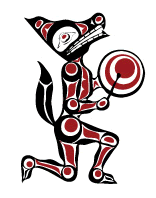

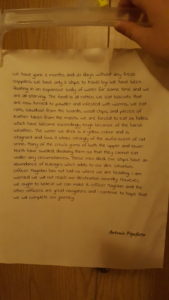
 minds. Another criteria which I think a genius should have is that these people are creativeand made great contributions to society through their works and discoveries. One person of the Renaissance who definitely stands out as a genius is the “Renaissance Man”: Leonardo D
minds. Another criteria which I think a genius should have is that these people are creativeand made great contributions to society through their works and discoveries. One person of the Renaissance who definitely stands out as a genius is the “Renaissance Man”: Leonardo D a Vinci. He was a famous painter, inventor, engineer, and scientist who made many great works, such as the Mona Lisa, a tank, and a flying machine, that contributed to the Renaissance. Some other geniuses of that time were Francis Bacon, who promoted the scientific method during the scientific revolution, and William Shakespeare, who wrote many famous, classic plays and sonnets and invented many words and popular sayings. Galileo was skilled in physics, math, and astronomy,and by making an improved telescope, concluded that Copernicus’ theory of the sun-centered
a Vinci. He was a famous painter, inventor, engineer, and scientist who made many great works, such as the Mona Lisa, a tank, and a flying machine, that contributed to the Renaissance. Some other geniuses of that time were Francis Bacon, who promoted the scientific method during the scientific revolution, and William Shakespeare, who wrote many famous, classic plays and sonnets and invented many words and popular sayings. Galileo was skilled in physics, math, and astronomy,and by making an improved telescope, concluded that Copernicus’ theory of the sun-centered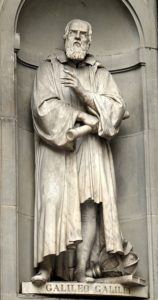 solar system was true. Issac Newton also was accomplished in math, physics, and astronomy. He discovered the nature of white light, invented the reflecting telescope, and discovered the law of gravity. These are just a few examples of geniuses from the Renaissance, but there are many more. The handout also says that the era of big geniuses may be over, but this won’t stop people from making new discoveries. So, what does make someone a genius? In my opinion, a genius is creative, is good at what they’re doing, and their works and discoveries make significant impact on society.
solar system was true. Issac Newton also was accomplished in math, physics, and astronomy. He discovered the nature of white light, invented the reflecting telescope, and discovered the law of gravity. These are just a few examples of geniuses from the Renaissance, but there are many more. The handout also says that the era of big geniuses may be over, but this won’t stop people from making new discoveries. So, what does make someone a genius? In my opinion, a genius is creative, is good at what they’re doing, and their works and discoveries make significant impact on society.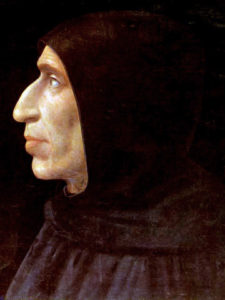 were Catherine de Medici, a patron of the arts, Francis Bacon, who promoted the scientific method, Johann Gutenberg, who invented the printing press, Titian, who was the official artist of Venice, and many more! At the dinner party, I played the role of Savonarola. He, or “I”, was a preacher,argued for equality,and dedicated his life to reforming the corruption of the church and society. It was a fun activity, and I learned a lot about the many important and influential people of the Renaissance and what they did that brought about this rebirth in culture.
were Catherine de Medici, a patron of the arts, Francis Bacon, who promoted the scientific method, Johann Gutenberg, who invented the printing press, Titian, who was the official artist of Venice, and many more! At the dinner party, I played the role of Savonarola. He, or “I”, was a preacher,argued for equality,and dedicated his life to reforming the corruption of the church and society. It was a fun activity, and I learned a lot about the many important and influential people of the Renaissance and what they did that brought about this rebirth in culture. The Renaissance was a time of rebirth and change, and it started in Italy for many different reasons. First of all, it was the heartland of the old Roman Empire. This meant they used the Roman legal code which made trade bet
The Renaissance was a time of rebirth and change, and it started in Italy for many different reasons. First of all, it was the heartland of the old Roman Empire. This meant they used the Roman legal code which made trade bet ween other regions easier. The Roman ruins, sculptures, mosaics, and wall paintings also contributed to the Renaissance by inspiring many Italian artists and architects. Geography was another important factor in the reason why the Renaissance started in Italy. This country is a mountainous peninsula which allowed for only a few busy trade routes, but this made the cities on the route very powerful. Some of these city states, such as Florence and Venice, became very wealthy through trade, which also contributed to the Renaissance. To create a Renaissance, you need a great amount of money, which man
ween other regions easier. The Roman ruins, sculptures, mosaics, and wall paintings also contributed to the Renaissance by inspiring many Italian artists and architects. Geography was another important factor in the reason why the Renaissance started in Italy. This country is a mountainous peninsula which allowed for only a few busy trade routes, but this made the cities on the route very powerful. Some of these city states, such as Florence and Venice, became very wealthy through trade, which also contributed to the Renaissance. To create a Renaissance, you need a great amount of money, which man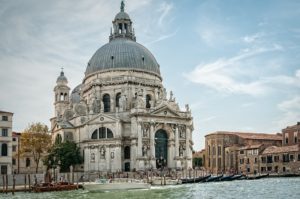 wed for people to have more time to learn, which was a huge part of the Renaissance, instead of working. Location was essential too. Italy had closer ties to the Muslim world than the rest of Europe, which meant trade was cheaper and easier. They were closer to the Middle East and Africa, and from these regions they could trade for products such as oranges, lemons, coffee, and sugar, were introduced to science, medicine, and astronomy, and were exposed to new ideas. Clearly, all of these components are very important parts of why the Renaissance started in Italy.
wed for people to have more time to learn, which was a huge part of the Renaissance, instead of working. Location was essential too. Italy had closer ties to the Muslim world than the rest of Europe, which meant trade was cheaper and easier. They were closer to the Middle East and Africa, and from these regions they could trade for products such as oranges, lemons, coffee, and sugar, were introduced to science, medicine, and astronomy, and were exposed to new ideas. Clearly, all of these components are very important parts of why the Renaissance started in Italy. e is in the “Top Ten Castles” list, it is not, in fact, a castle, but a medieval fortress and walled city. Carcassonne is located in the Aude department in the region of Occitane, which is in southwest France. It is on a hilltop in the Aude plains. It is between the Atlantic and Mediterranean, which gave it a very important postion on the medieval trade route. Carcassonne, or “Cité de Carcassonne”, was a town surrounded by 2 outer walls: the lower and higher walls. The lower was for defense whereas the higher walls had many towers. Cité de Carcassonne had 1-mile long fortifications encircling the city, 53 towers, barbicans, a drawbridge, and a ditch leading to a central keep. The wall also had a section distinctively built by Romans; it was made of red bricks, was built in the 13th century, and was called the “Inquistion Tower”. Inside it’s walls, Carcassonne was a medieval town; it had cobbled streets, alley ways, stone walls, houses, archways, a cathedral, and a “chateau” (castle). Settlement in the region dated back to 3500 BC, and the fortress was occupied for over 5000 years. Romans first fortified the hilltop upon which Carcassonne stood in 100 BC, it was also an important trading place since the 6th century BC. However, as Carcassonne’s conditions were declining, it’s rebuilding
e is in the “Top Ten Castles” list, it is not, in fact, a castle, but a medieval fortress and walled city. Carcassonne is located in the Aude department in the region of Occitane, which is in southwest France. It is on a hilltop in the Aude plains. It is between the Atlantic and Mediterranean, which gave it a very important postion on the medieval trade route. Carcassonne, or “Cité de Carcassonne”, was a town surrounded by 2 outer walls: the lower and higher walls. The lower was for defense whereas the higher walls had many towers. Cité de Carcassonne had 1-mile long fortifications encircling the city, 53 towers, barbicans, a drawbridge, and a ditch leading to a central keep. The wall also had a section distinctively built by Romans; it was made of red bricks, was built in the 13th century, and was called the “Inquistion Tower”. Inside it’s walls, Carcassonne was a medieval town; it had cobbled streets, alley ways, stone walls, houses, archways, a cathedral, and a “chateau” (castle). Settlement in the region dated back to 3500 BC, and the fortress was occupied for over 5000 years. Romans first fortified the hilltop upon which Carcassonne stood in 100 BC, it was also an important trading place since the 6th century BC. However, as Carcassonne’s conditions were declining, it’s rebuilding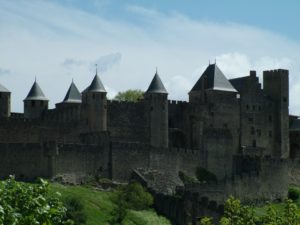 began in 1853 to restore it to what it once was. When the Romans lived in Carcassonne, they named it “Carcaso”. In 426, the Romans then started Septimania to Visigothic King Theodoric 2 who had reigned since 453. Saracens from Barcelona took over in 725, and after that, Napoleon. In a typical castle though, the more specific people groups were blacksmiths, wheelwrights, carpenters, candle makers, marshals, clerks, stewards, bailiffs, priests, pantlers, butlers, ewers, pages, grooms, farmers, soldiers, archers, a baron or lord, a lady, armorers, swordsmiths, arrow smiths, a jester, and reeves. Some things that some of these people groups did were that the marshal was in charge of the garrison and deciding who should have which rooms, clerks kept accounts, stewards were in charge of the household, bailiffs collected rent, reeves managed the lord’s farms, priests held services and were secretaries for the castle, pantlers bought food, butlers dispensed wine, and ewers did laundry and cleaned cloths for the table. Carcassonne was a grand medieval city, and now is a famous tourist attraction in France. This fortress truly deserves to be on the Top 10 Castles list.
began in 1853 to restore it to what it once was. When the Romans lived in Carcassonne, they named it “Carcaso”. In 426, the Romans then started Septimania to Visigothic King Theodoric 2 who had reigned since 453. Saracens from Barcelona took over in 725, and after that, Napoleon. In a typical castle though, the more specific people groups were blacksmiths, wheelwrights, carpenters, candle makers, marshals, clerks, stewards, bailiffs, priests, pantlers, butlers, ewers, pages, grooms, farmers, soldiers, archers, a baron or lord, a lady, armorers, swordsmiths, arrow smiths, a jester, and reeves. Some things that some of these people groups did were that the marshal was in charge of the garrison and deciding who should have which rooms, clerks kept accounts, stewards were in charge of the household, bailiffs collected rent, reeves managed the lord’s farms, priests held services and were secretaries for the castle, pantlers bought food, butlers dispensed wine, and ewers did laundry and cleaned cloths for the table. Carcassonne was a grand medieval city, and now is a famous tourist attraction in France. This fortress truly deserves to be on the Top 10 Castles list.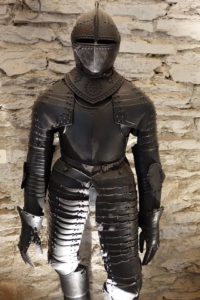 ortable since they were made of chain mail or plates of metal. Samurai also had 2 different swords: the katana (longer) and the wakizashi (s
ortable since they were made of chain mail or plates of metal. Samurai also had 2 different swords: the katana (longer) and the wakizashi (s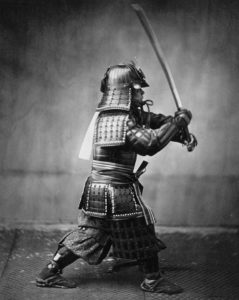 horter). Armed with these swords, samurai were ready to fight whenever they needed to. The samurai code called “Bushido” or ” Way of the Warrior” was very important to follow. This code required the samurai to give allegiance to his/her lord and fellow samurai. However, this code did not require that they protect the weak, whereas the knight’s code (the Chivalry) did. This may suggest that the samurai weren’t great heroes if they didn’t protect the weak, but even though the knight’s code required the weak to be protected, the knights
horter). Armed with these swords, samurai were ready to fight whenever they needed to. The samurai code called “Bushido” or ” Way of the Warrior” was very important to follow. This code required the samurai to give allegiance to his/her lord and fellow samurai. However, this code did not require that they protect the weak, whereas the knight’s code (the Chivalry) did. This may suggest that the samurai weren’t great heroes if they didn’t protect the weak, but even though the knight’s code required the weak to be protected, the knights  didn’t always necessarily follow that rule all the time, on the other hand, the samurai always obeyed the Code of Bushido. The samurai went to great lengths to keep the rules of the Bushido and their honour. They would even make great sacrifices, including killing themselves, to keep these conventions. These are the reasons why I think the samurai are greater heroes than knights.
didn’t always necessarily follow that rule all the time, on the other hand, the samurai always obeyed the Code of Bushido. The samurai went to great lengths to keep the rules of the Bushido and their honour. They would even make great sacrifices, including killing themselves, to keep these conventions. These are the reasons why I think the samurai are greater heroes than knights.